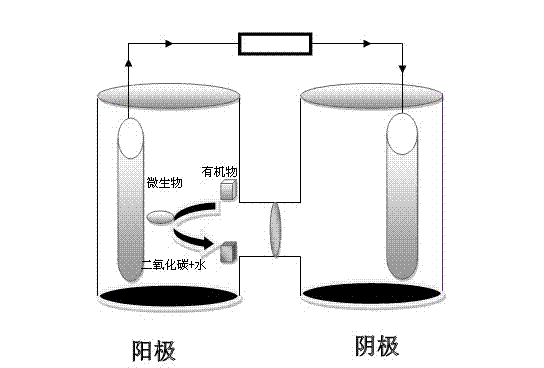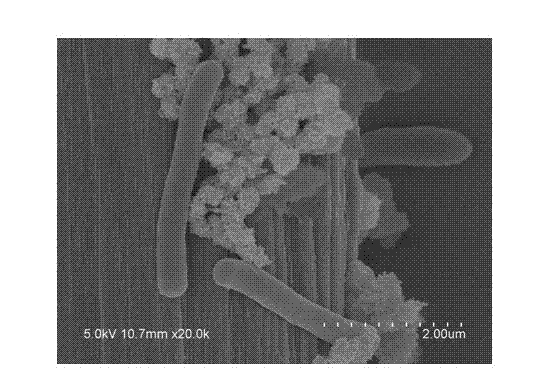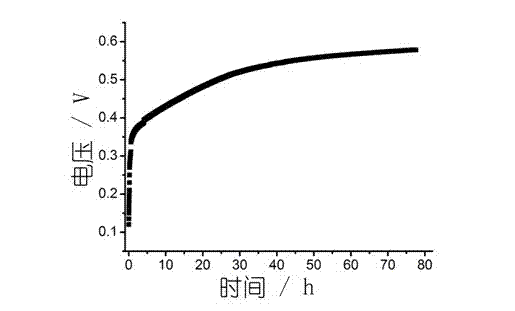Bacillus cereus with electrogenesis characteristic and application thereof in microbiological fuel cell
A Bacillus cereus and fuel cell technology, applied in the biological field, to achieve good electricity production capacity, broad industrial application potential, and high electroactivity
- Summary
- Abstract
- Description
- Claims
- Application Information
AI Technical Summary
Problems solved by technology
Method used
Image
Examples
Embodiment 1
[0019] Embodiment 1: Screening of MFC-1 bacterial strain
[0020] In the natural wastewater on the campus of Nanjing University, take 500ml of natural wastewater and put it into the anode chamber of the microbial fuel cell. The microbial fuel cell device adopts an H-shaped double-chamber structure ( figure 1 ), consisting of two glass bottles, which are connected with a glass tube connected to the glass bottle, and DuPont’s Nafion 211 proton exchange membrane is used in the middle, and the two chambers are tightened and connected with clips. The electrodes are made of high-purity carbon paper. The wires are connected with copper wire, and the exposed part is stuck with glue. The external circuit is connected with a 1000Ω fixed resistor, and the potential difference between the two ends of the resistor is measured with a multimeter. The anode of the battery is fed with high-purity nitrogen to ensure anaerobic state, and the cathode uses potassium ferricyanide solution. Place ...
Embodiment 2
[0022] Embodiment 2: the cultivation of MFC-1 bacterial strain
[0023] Pick the MFC-1 strain cultured in LB medium, inoculate it into a 15mL centrifuge tube containing 5mL LB medium, at 37 ℃, 120 rpm, after culturing for 12 hours, add it with 1% inoculum to 250 ml to In a 500 ml Erlenmeyer flask of the following medium, the content of the medium per liter: 10g C 6 h 12 o 6 , 5g yeast extract, 10g NaHCO 3 , 8.5g NaH 2 PO 4 , 37°C, 120 rpm, after culturing for 12 hours, centrifuge under anaerobic environment to obtain the bacteria again, which is used for the study of microbial electricity production.
[0024]
Embodiment 3
[0025] Embodiment 3: the electricity production of MFC-1 bacterial strain
[0026]According to the culture and inoculation methods described in Example 2, cells in the late logarithmic growth period were obtained from 200mL medium with glucose as the electron donor, centrifuged under anaerobic conditions (8000rpm, 10min), washed three times with 50mM PBS buffer Re-dispersed into anaerobic medium with 50mM glucose as electron donor, inoculated into the anode of the microbial fuel cell. The anode chamber keeps anaerobic environment through high-purity nitrogen, and the catholyte is potassium ferricyanide solution of 0.1M PBS buffer solution as the electron acceptor. The battery device and operating conditions are as described in Example 1. The external resistance adopts 1000 ohms. The terminal voltage is recorded every 5 minutes with a multimeter, and the process of battery power generation is shown in image 3 shown.
PUM
| Property | Measurement | Unit |
|---|---|---|
| diameter | aaaaa | aaaaa |
Abstract
Description
Claims
Application Information
 Login to View More
Login to View More - R&D
- Intellectual Property
- Life Sciences
- Materials
- Tech Scout
- Unparalleled Data Quality
- Higher Quality Content
- 60% Fewer Hallucinations
Browse by: Latest US Patents, China's latest patents, Technical Efficacy Thesaurus, Application Domain, Technology Topic, Popular Technical Reports.
© 2025 PatSnap. All rights reserved.Legal|Privacy policy|Modern Slavery Act Transparency Statement|Sitemap|About US| Contact US: help@patsnap.com



